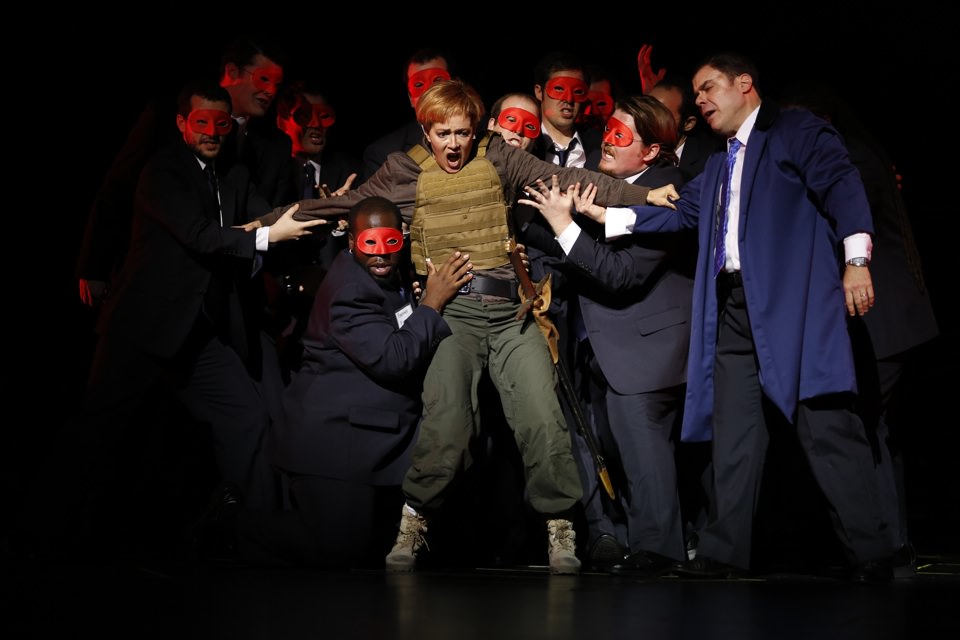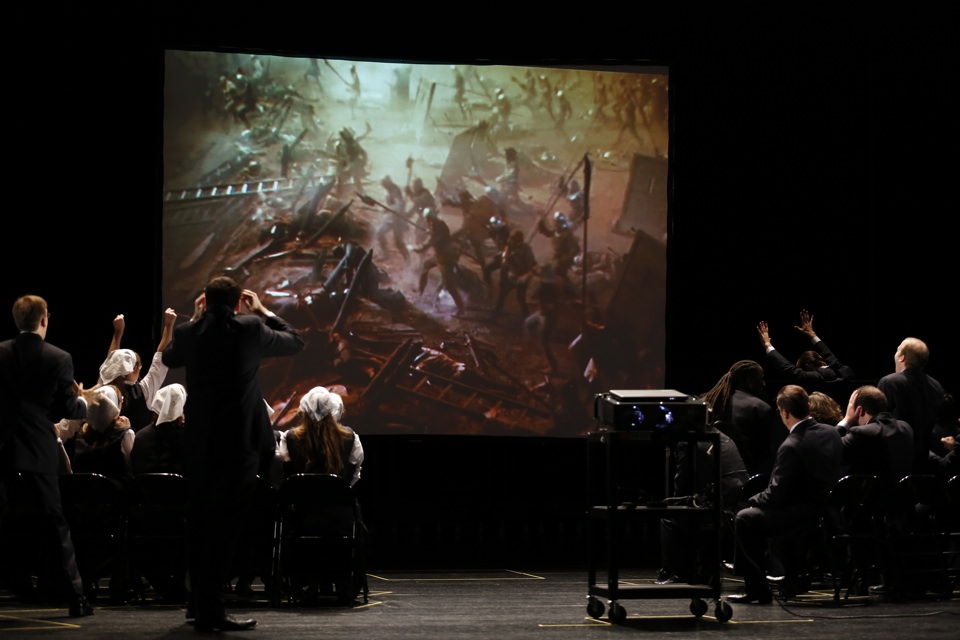Like all of Verdi’s early operas, the seventh one, Giovanna d’Arco (Joan of Arc) (1845), has been revived and given multiple recordings in recent years. In this bicentennial year of Verdi’s birth, it has been performed in Salzburg with Placido Domingo in one of his new baritone roles as Giovanna’s father. On September 21, the Chicago Opera Theater presented what it billed as the first performance from the new scholarly edition in the great University of Chicago Verdi series, this one edited by Alberto Rizzuti. In recent decades, this once-popular opera has been newly appreciated.
Yet there is no denying that the work tugs against some of a modern audience’s values. When, for instance, Giovanna is accused of witchcraft, she is unable to deny it because she has fallen in love with the Dauphin she is striving to make King. Why does she feel that a love for an unmarried Christian man, one not even sexually satisfied, must paralyze her with guilt?
Schiller’s play, Die Jungfrau von Orleans (1801), which gave Temistocle Solera, Verdi’s librettist, much of his material, is more convincing on this point. Schiller’s Johanna falls in love with a soldier in the English army she is fighting. This adds an element of betrayal to her country, and explains her guilt. His Johanna purifies herself from this lapse into love for the enemy and goes on to die fighting for her cause.
What then are we to make of Verdi’s Giovanna, guilty merely of feeling love for her fellow leader in the good cause? The Chicago Opera Theater director, David Schweizer, decided that the only way to be convincing about such an obsession with sexual purity is to make the opera show “the perpetual heart-rending consequences of religious fanaticism.” So he frames the opera as one presented by a group of American evangelicals. When we entered Chicago’s Harris Theater, earnest young religious types passed out fliers thanking us for joining their meeting. Then we saw the meeting begin onstage, the cultists assembling under their pastor, who will play Giovanna’s faith-healing father, Giacomo, in the opera. The cultists, who have come with folding chairs, sit on them during Verdi’s orchestral prelude, watching clips from the 1948 Victor Fleming movie, with Ingrid Bergman as Joan. The evangelicals make ecstatic mourning gestures as Joan is seen burning at the stake, but cheering ones as she goes into battle with shining armor.
At a University of Chicago symposium before the production, David Schweizer was asked why he chose Fleming’s over other films about Joan (by Dreyer or Bresson, for instance). He answered that he wanted to show the shallowest and “most Hollywood” images he could find. The film is geared to the fanatics’ capacities. The way Schweizer was stacking the deck came out in the symposium when Philip Gossett, the eminent editor in chief of the Verdi editions, asked a question. The Joan of the production, soprano Suzan Hanson, had just sung (to piano accompaniment) her early prayer for armor. Gossett, following along with the new score, noted that she sang the version that had been censored for Austrian audiences in the nineteenth century, which omitted the person being prayed to, though Verdi’s original text, just re-edited, names “Vergin Maria.” Why desert the new text now that they have it and claim to be presenting it?
The conductor of the Chicago production, Francesco Milioto, said they kept the old text because they are depicting Fundamentalist fanatics who do not pray to the Virgin Mary. He said he was not mocking real (non-fundamentalist) religion. “Our reason is not the same as the Austrians. We’re not shying away from religion—and neither were the Austrians.” But the Austrians were, in fact, shying away from what they considered an illegitimate use of religion, as Maestro Milioto could have learned from the new edition. It cites an important article by the scholar of nineteenth-century opera Francesco Izzo, showing that Solera and Verdi made unusual use of Mary in the brief time (the 1840s) when she was seen as a Risorgimento patroness of liberty—like an Italian version of the French Marianne.
The Church of Pius IX was in collaboration with the Austrians, and it was shocked that “their” meek and mild Virgin could be glimpsed on the other side of the barricades. This was made strikingly clear when, during the brief liberation of Milan in 1848, three years after Verdi’s opera, the radical Princess Cristina Belgioioso (a friend to Verdi’s circle) led 160 troops into Milan. She was costumed, at the head of her little army, as Joan of Arc. Marianne, indeed! (The Chicago company’s program lists ten women in history who wore armor with the troops, but does not mention the most relevant—Princess Belgioioso.)
Advertisement
These are not matters incidental to the opera. Verdi’s Joan does not stay virgin because she feels that all sex is sin, but because she is the living representative of the Virgin. That is why she can redeem herself by rededication to her mission, and die, as in Schiller’s play, gloriously fighting for the cause. Neither in Schiller nor in Verdi is she a victim burned at the stake. But Schweizer’s production, responding perhaps to its own shallow clue given by Ingrid Bergman, gives her a quasi-incineration. In both play and opera, she is imprisoned with chains after being captured by the English. Here the cultists lift her onto a stake and stack their folding chairs as to form the pyre under her. Yet her pastor-father hears her praying to the true God and brings her down from the stake by a miracle (this pastor was earlier seen faith-healing English soldiers).
The Virgin Mary does show up in this staging, but not as an object of Giovanna’s devotion. When the Dauphin has a vision of the place where he can give up his armor, it is at a shrine to Mary. Here the kitchiest kind of Marian image pops up, with lots of candles burning in front of it as in a Catholic church. This is a Mary of the Fundamentalists’ horror, doing the devil’s work. No wonder her father concludes from the shrine that she is leagued with hell, and tells both the French and the English that she should die. But once convinced that she is praying to the proper God, on her pyre, he sends her back into battle.
She was not allowed to pray to Mary herself, because that is not her infidelity. Sexual desire is. In its grip, she thrashes in the convulsions of diabolical possession. Verdi gave the devils offstage voices, but the Chicago production brings them on as dancing demons (the people in the audience near me tittered). At the final scene, of her death from battle wounds, she is no longer in the guerrilla war garb she wore earlier, but clothed in glittering armor—the same Ingrid Bergman was seen wearing in the prelude. With her restored purity she ascends to a true believers’ heaven, while her cultists turn semi-automatic weapons on the audience, heavy-handedly linking Giovanna to terrorism.
I doubt that Verdi will do much damage to the jihadists of the world. One might expect that a production working from such a crackpot premise would be weak or ill-performed, but it is not. Michael Chioldi is a wonderful Giacomo. Suzan Hanson has the high declamatory style of this stage in Verdi, and Steven Harrison sings well as the King, but without the power to match Hanson in their duets. Chorus and orchestra are admirable. This is another case of Verdi’s music triumphing over a director’s most energetic pretzel-twistings. Verdi always rewards the ears, no matter what tricks are being played on the eyes.
The Chicago Opera Theater’s production of Joan of Arc is playing at the Harris Theater for Music and Dance through September 29.




